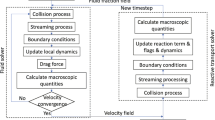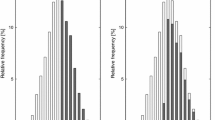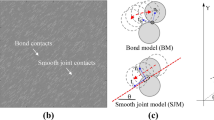Abstract
Fracture growth in saturated porous bodies under the action of the osmotic pressure developed in the fracture by a solute for which the fracture surface represents a semipermeable membrane is considered. This mechanism of fracture growth, which follows directly from the basic laws of fracture mechanics and physical chemistry, should be a fairly general effect of significance in a number of geochemical and technological processes. In particular, the role of osmosis in well flushing and cementing processes was noted in study by N. G. Avetisyan, “Choice of type of drill solution for drilling in unstable rocks,” published in: Review Information. Drilling [in Russian], VNIIOENG (1983) and the mechanism was briefly discussed in monograph by A. Kh. Mirzadzhanzade and V. M. Entov, Drilling Hydrodynamics [in Russian], Nedra, Moscow (1985).
In study by R. V. Gol'dshtein, V. M. Entov, and B. P. Pavlovskii, “Model of the development of hydrogen fractures in metal,” Dokl. Acad. Nauk SSSR, Vol. 237, 828 (1977) a comparable mathematical model was proposed for explaining the hydrogen embrittlement of metals. Finally, in study by J. P. Sargent and K. H. G. Ashbee, “The contribution of osmosis to dimensional instability of adhesive joints,” J. Adhesion, Vol. 17, 83 (1984) a very similar mechanism of fracture development in polymeric materials due to the osmotic splitting of internal joints as a result of the release in the joints of a substance dissolved in the solid polymer was discussed and visual observation data were given.
The property of semipermeability of the fracture surface (permeability for water and impermeability for dissolved salts), which is fundamental to our study, is taken as a basic hypothesis and will not discussed in what follows. Many arguments could be advanced to show that natural semipermeable membranes can develop in rocks, especially in argillaceous ones. However, these arguments are not definite and clearly lie beyond the competence of the authors whose task is to trace the possible mechanical consequences of the presence of semipermeable membranes and draw them to the attention of the specialists.
Similar content being viewed by others
REFERENCES
N. G. Avetisyan, “Choice of type of drill solution for drilling in unstable rocks,” in: Review Information. Drilling [in Russian], VNIIOENG (1983).
A. Kh. Mirzadzhanzade and V. M. Entov, Drilling Hydrodynamics [in Russian], Nedra, Moscow (1985).
R. V. Gol'dshtein, V. M. Entov, and B. P. Pavlovskii, “Model of the development of hydrogen fractures in metal,” Dokl. Acad. Nauk SSSR, 237, 828 (1977).
J. P. Sargent and K. H. G. Ashbee, “The contribution of osmosis to dimensional instability of adhesive joints,” J. Adhesion, 17, 83 (1984).
Yu. I. Dytnerskii, Inverse Osmosis and Ultrafiltration [in Russian], Khimiya, Moscow (1978).
A. B. Mlodzeevskii, Short Course of Molecular Physics [in Russian], Gostekhizdat, Moscow, Leningrad (1934).
Chemical Encyclopedia, Vol. 3. [in Russian], Sov. Entsiklopediya, Moscow (1992).
G. I. Barenblatt, V. M. Entov, and V. M. Ryzhik, Theory of Unsteady Liquid and Gas Flow through Porous Media [in Russian], Nedra, Moscow (1972).
Ya. S. Uflyand, Integral Transforms in Problems of Elasticity Theory [in Russian], Nauka, Moscow (1967).
G. I. Barenblatt, “Mathematical theory of equilibrium cracks formed in brittle fracture,” Zh. Prikl. Mekh. Tekh. Fiz., No. 4, 3 (1961).
I. N. Sneddon, Fourier Transforms, McGraw-Hill, New York (1951).
V. N. Nikolaevskii, Geomechanics and Fluidodynamics [in Russian], Nauka, Moscow (1996).
Rights and permissions
About this article
Cite this article
Gordeev, Y.N., Entov, V.M. Osmotic Mechanism of Fracture Growth in Saturated Porous Media. Fluid Dynamics 36, 964–970 (2001). https://doi.org/10.1023/A:1017922912068
Issue Date:
DOI: https://doi.org/10.1023/A:1017922912068




